The Nexus 7 (2013) Review
by Anand Lal Shimpi on August 22, 2013 6:00 PM ESTPlatform Power & Battery Life
The new Nexus 7 moves to a slightly smaller battery compared to its predecessor (15Wh vs. 16Wh). The result however is anything but a reduction in battery life. ASUS and Google worked hard to reduce platform power consumption as much as possible. I instrumented both Nexus 7s and measured total platform power, excluding display, to look at the impact of the silicon platform (SoC, PMIC, DRAM, eMMC, WiFi, etc...). The results are beyond impressive:
Idle power is cut in half compared to last year's model. This is by far the most important improvement as most mobile usage models tend to have long periods of idle time. We'll see these power gains reflected in our web browsing test which does have significant periods of simulated reading time between web page loads. The power reduction while running Kraken grows to just over 20%, and even while running Geekbench 3 we see a 16% drop with the new Nexus 7. Only our offscreen 3D test manages to draw more power on the new Nexus 7 than the old one, and that isn't taking into account the nearly 5x increase in performance on the new Nexus. In fact, as impressive as these numbers are - they are even more impressive when you take into account performance. To make a long story short, don't worry about the ~7% decrease in battery capacity as there are enough improvements in platform power and performance (and thus perf per watt) to more than make up for the smaller battery.
We'll start out with our WiFi web browsing test. Like all of our battery life benchmarks we run this test with all devices calibrated to 200 nits and connected to 5GHz 802.11 WiFi (if supported). The test itself cycles through a bunch of desktop websites at a very aggressive frequency. Our test ensures that both the CPU cores and wireless stack can reach their deep sleep states during simulated reading periods. The test continues until the battery is depleted.
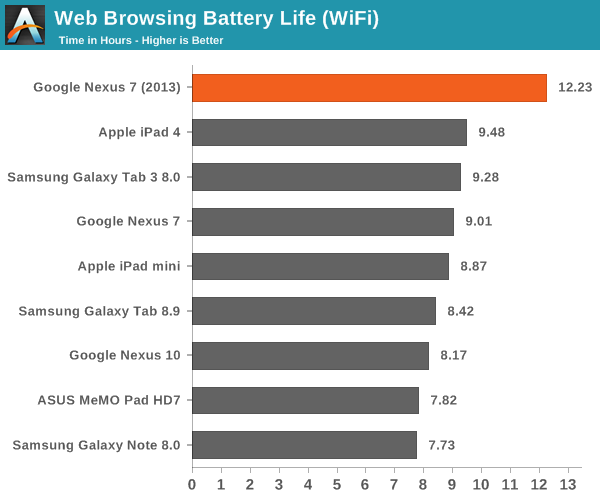
The new Nexus 7 does better here than any other small tablet we've ever tested. Remember that 50% decrease in idle platform power? That's exactly why we're seeing a 35% improvement in battery life compared to the original Nexus 7.
Our video playback test involves looping the playback of a 4Mbps 720p High Profile H.264 transcode of the last Harry Potter Blu-ray. All displays are calibrated to 200 nits.
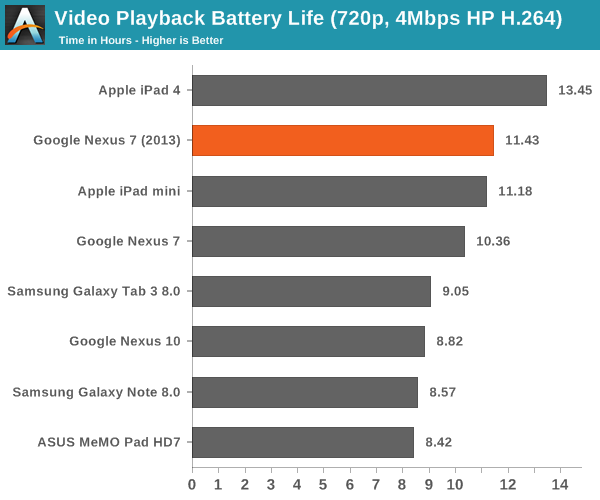
Video decode blocks are fairly well optimized to begin with, so there's not a ton of room for improvement here compared to last year's Nexus 7. Despite the ~7% shrink in battery capacity, the new model manages a 10% increase in battery life though. We also have the first small Android tablet capable of beating the iPad mini in a video playback test here - job well done ASUS/Google.
Our final test involves looping the Egypt HD benchmark until the battery is completely drained. Frame rates are capped to 30 fps to somewhat simulate actual gameplay and not penalize faster GPUs.
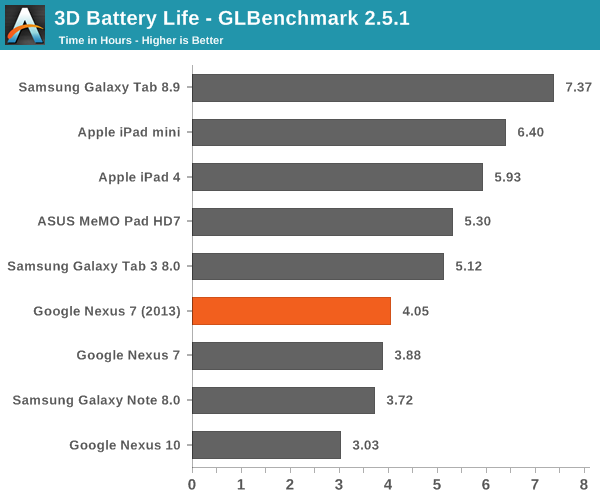
The new Nexus 7 manages to deliver slightly better battery life here despite driving higher frame rates and more pixels. Overall performance here isn't anything super impressive, the only average showing from the Nexus 7.
Google ships the Nexus 7 with an ASUS branded 7W charger, identical to the one you'd find in the box of a MeMO Pad HD7. Given identical chargers and battery capacities, there's no surprise the new Nexus 7 takes the same amount of time to charge as the MeMO Pad HD7 (~3.5 hours).
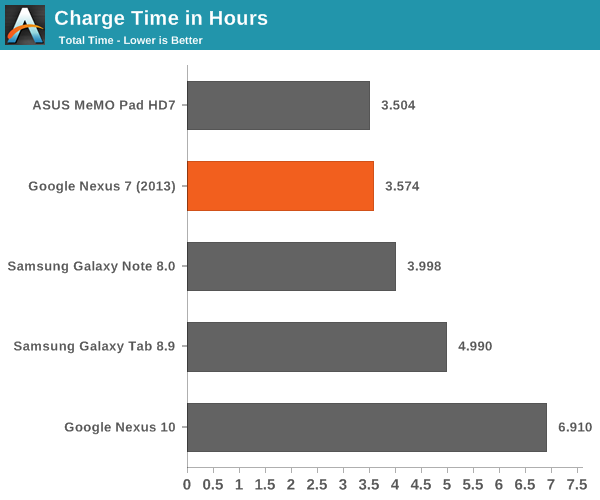
The new Nexus 7 also supports wireless charging by implementing the Qi standard. Charge time is a bit slower wirelessly as Qi can only charge at up to 5W. Brian tested Qi functionality in his mini review of the Nexus 7 and didn't have any issues.


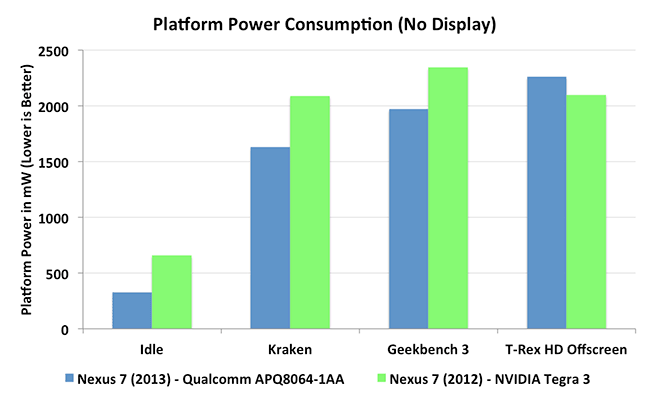









202 Comments
View All Comments
vailr - Friday, August 23, 2013 - link
Won't Amazon be updating their Kindle Fire lineup pretty soon? Although not ideal: the 8.9" Kindle Fire could be improved by addition of an SD card slot, and an easier option of rooting and installing the stock Android 4.3 O.S. (not too likely, I'd guess).Impulses - Friday, August 23, 2013 - link
Not too likely at all, on either count.Conficio - Friday, August 23, 2013 - link
Anand, have you ever run comparison tests between 200, 300, 400, 500 nits display? It would be nice to get an idea as to what battery life one can expect if the display is used outdoor, where you need the brighter display. Just one or two tablets/phones would be fine to get an idea. The Nexus 7 '13 seems to be a good candidate with its high max brightness.ASEdouardD - Saturday, August 24, 2013 - link
You can check out Engadget's review for something similar to this. They use brightness fixed at at 65 % (if I remember correctly) which is much higher than 200 nits on the new Nexus 7. If you have to use one test, Anandtech definitely has the best one, but Engadget's one does give you an idea of the impact of cranking up the brightness on the N7. Bottom line, battery life does take a hit, but it's still ok.iamkyle - Friday, August 23, 2013 - link
I don't see how this product can be called "the best" especially when Google/Asus has essentially railroaded purchasers of the 2012 Nexus 7. "Oh hey, I know we sold you this tablet, but check this one out! It's the same, but better!".Customer says "then why did you sell me this one in the first place?"
This endless praise of anything with a Google name on it reeks of bias.
turkeystyle - Friday, August 23, 2013 - link
For real! Nissan did the same thing to me when I bought an Altima a couple of years back. The next year's model was better but for the same price! And good god, my Galaxy S3 is barely a year old and what does Samsung do? Release the S4! The nerve! And don't even get me started on Nvdia and AMD and how they keep making better graphics cards every year.My buddy did the smart thing and bought an iPhone 5 last year. He's got at least another year before Apple releases an upgrade. So lucky to have the latest and greatest technology for that long!
But yeah, Google is definitely the worst. They just try to hide it by giving away web services.
meloz - Friday, August 23, 2013 - link
>Customer says "then why did you sell me this one in the first place?"While we wonder why you _bought_ it in the first place.
Thinly disguised Appletroll, you must do a better job.
ASEdouardD - Saturday, August 24, 2013 - link
You can't be for real. They didn't offer this product last year because available components and the prices of those components change every year. Prices go down, technology gets better. Google/Asus couldn't have offered a tablet like this at this price last year. Just plain impossible.Davidjan - Friday, August 23, 2013 - link
I had Nexus 7 I. I will buy Nexus 7 II. It is really convenient to extend its storage with : http://goo.gl/U6IyYImpulses - Saturday, August 24, 2013 - link
I ordered two of those... Not sure how much I'll really use it tho, might keep one on my keychain along with my regular USB micro reader and see how often I have the opportunity to use it, but for traveling and transferring loads of content from a PC (i.e. movies) I'd rather use a regular USB OTG adapter and a much faster USB 3.0 drive... It's going into my travel bag until I'm sitting down on a plane/train/hotel either way.